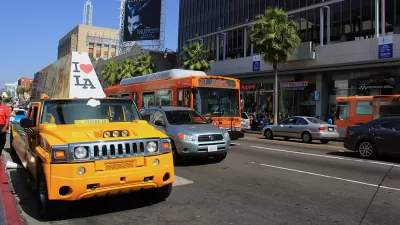At long last, California law will consider the amount of driving, rather than vehicle delay, when evaluating the environmental impacts of new developments. This is a more common-sense approximation of their environmental impacts.

"Starting Wednesday, at long last, vehicle delay will no longer be considered an impact to the environment under California environmental law. Instead, the amount of driving – rather than the smooth flow of driving – must be measured. This is a more common-sense approximation of the environmental damage from vehicle trips serving new development than mere delay to drivers, but the old way was so entrenched that it has taken years to get to this point," reports Melanie Curry.
"When S.B. 743 finally goes into effect, long commutes and suburban housing will not suddenly cease to exist. What will happen is that, under California environmental law, the amount of driving that new projects produce will have to be estimated, and if it is excessive, it will have to somehow be mitigated. Shenanigans to sidestep CEQA won’t stop, but the focus will shift from the current practice of mitigating congestion by building wider, faster roads – thus encouraging more driving and indeed ensuring it is the only viable way to get around – to finding ways to encourage more sustainable and healthy and less environmentally harmful travel – such as walking, biking, and, yes, transit."
"The new rules will make it easier to build housing near transit and jobs, where fewer car trips would be generated, because trying to mitigate for congestion – via wider roads and intersections – is much more difficult and expensive in built-up areas, and that burden will be removed. This can also make investments in sustainable and innovative transportation solutions, like ride sharing and micromobility, much easier for local and regional agencies. Those investments, in turn, can increase accessibility for residents who do not own cars."
FULL STORY: New Rule on Environmental Impacts of Driving, Long Awaited, Goes Into Effect on Wednesday

Alabama: Trump Terminates Settlements for Black Communities Harmed By Raw Sewage
Trump deemed the landmark civil rights agreement “illegal DEI and environmental justice policy.”

Planetizen Federal Action Tracker
A weekly monitor of how Trump’s orders and actions are impacting planners and planning in America.

How Atlanta Built 7,000 Housing Units in 3 Years
The city’s comprehensive, neighborhood-focused housing strategy focuses on identifying properties and land that can be repurposed for housing and encouraging development in underserved neighborhoods.

In Both Crashes and Crime, Public Transportation is Far Safer than Driving
Contrary to popular assumptions, public transportation has far lower crash and crime rates than automobile travel. For safer communities, improve and encourage transit travel.

Report: Zoning Reforms Should Complement Nashville’s Ambitious Transit Plan
Without reform, restrictive zoning codes will limit the impact of the city’s planned transit expansion and could exclude some of the residents who depend on transit the most.

Judge Orders Release of Frozen IRA, IIJA Funding
The decision is a victory for environmental groups who charged that freezing funds for critical infrastructure and disaster response programs caused “real and irreparable harm” to communities.
Urban Design for Planners 1: Software Tools
This six-course series explores essential urban design concepts using open source software and equips planners with the tools they need to participate fully in the urban design process.
Planning for Universal Design
Learn the tools for implementing Universal Design in planning regulations.
Jessamine County Fiscal Court
Caltrans
Institute for Housing and Urban Development Studies (IHS)
City of Grandview
Harvard GSD Executive Education
Toledo-Lucas County Plan Commissions
Salt Lake City
NYU Wagner Graduate School of Public Service





























